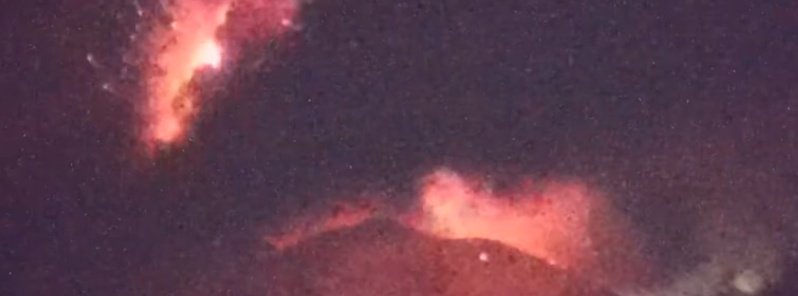Strong eruption at Agung volcano, ash to 9.1 km (30 000 feet), Indonesia

A strong eruption took place at Agung volcano, Bali, Indonesia at 17:40 UTC on June 12, 2019.
The eruptive pulse lasted 3 minutes and 53 seconds.
Volcanic ash rose up to 9.1 km (30 000 feet) above sea level, drifting southwest, according to data provided by Darwin VAAC. Secondary volcanic ash is rising up to 5.5 km (18 000 feet) a.s.l., drifting W and expected to dissipate within 12 hours.
The Aviation Color Code is Red.
The Alert Level remains at 3 (on a scale of 1-4) with the exclusion zone set at a 4 km (2.5 miles) radius.

Mount Agung Bali Volcano, eruption 13.06.2019, 02:00 Bali Time pic.twitter.com/93wHj6cl0E
— Rita Bauer (@wischweg) June 12, 2019
Eruption at #Agung volcano just now, at 01:38 local time 13th June. Its night in Bali, and Incandescence could be clearly observed. Now 10min. after the eruption, incandescence (hot material) can still be seen on the upper flanks of the summit. Sreenshot: from volcanoYT webcam pic.twitter.com/rdQ4KwUOPM
— Øystein Lund Andersen (@OysteinLAnderse) June 12, 2019
Summit changes of #Agung volcano, #Bali, between April 2019 – June 2019, observed with #Sentinel2 images. The signs of the last explosion (2019-06-10) are evident observing the images of 2019-06-07 / 12.@CopernicusEU @sentinel_hub @ESA_EO pic.twitter.com/4xBi7oreTk
— Annamaria Luongo (@annamaria_84) June 12, 2019
The 1963 eruption of Mount Agung is considered one of the world's largest eruptions of the 20th century. Nearly 1 600 people were killed.
Geological summary
Symmetrical Agung stratovolcano, Bali's highest and most sacred mountain, towers over the eastern end of the island. The volcano, whose name means "Paramount," rises above the SE caldera rim of neighboring Batur volcano, and the northern and southern flanks of Agung extend to the coast.
The 3142-m-high (10 308 feet) summit contains a steep-walled, 500-m-wide (1 640 feet), 200-m-deep (656 feet) crater. The flank cone Pawon is located low on the SE side.
Only a few eruptions dating back to the early 19th century have been recorded in historical time. The 1963-64 eruption, one of the world's largest of the 20th century, produced voluminous ashfall along with devastating pyroclastic flows and lahars that caused extensive damage and many fatalities.
Featured image: Eruption of Mount Agung on June 12, 2019. Credit: Tanya Homestay/Volcano YT

Commenting rules and guidelines
We value the thoughts and opinions of our readers and welcome healthy discussions on our website. In order to maintain a respectful and positive community, we ask that all commenters follow these rules:
We reserve the right to remove any comments that violate these rules. By commenting on our website, you agree to abide by these guidelines. Thank you for helping to create a positive and welcoming environment for all.